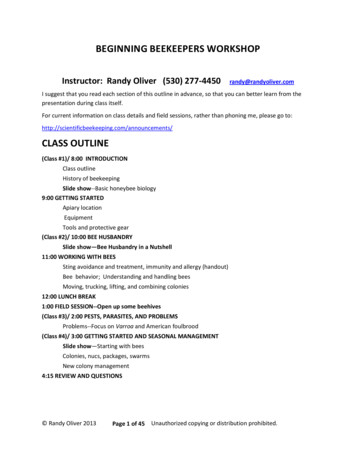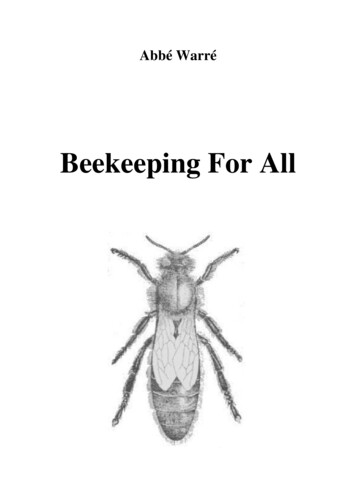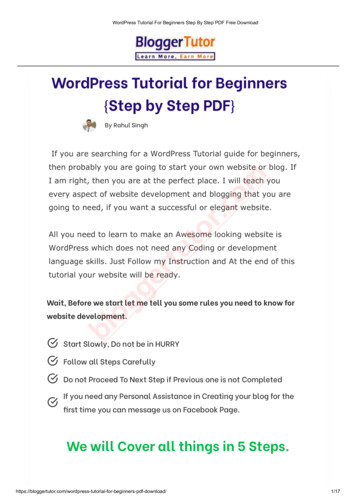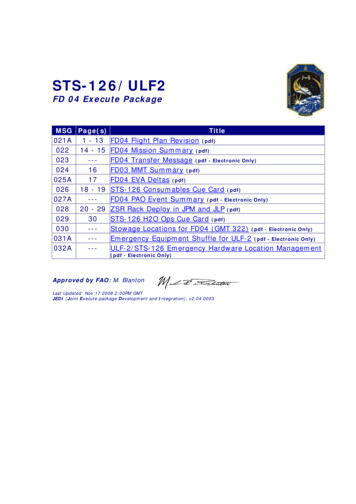
Transcription
BEGINNING BEEKEEPERS WORKSHOPInstructor: Randy Oliver (530) 277-4450randy@randyoliver.comI suggest that you read each section of this outline in advance, so that you can better learn from thepresentation during class itself.For current information on class details and field sessions, rather than phoning me, please go LASS OUTLINE(Class #1)/ 8:00 INTRODUCTIONClass outlineHistory of beekeepingSlide show--Basic honeybee biology9:00 GETTING STARTEDApiary locationEquipmentTools and protective gear(Class #2)/ 10:00 BEE HUSBANDRYSlide show—Bee Husbandry in a Nutshell11:00 WORKING WITH BEESSting avoidance and treatment, immunity and allergy (handout)Bee behavior; Understanding and handling beesMoving, trucking, lifting, and combining colonies12:00 LUNCH BREAK1:00 FIELD SESSION--Open up some beehives(Class #3)/ 2:00 PESTS, PARASITES, AND PROBLEMSProblems--Focus on Varroa and American foulbrood(Class #4)/ 3:00 GETTING STARTED AND SEASONAL MANAGEMENTSlide show—Starting with beesColonies, nucs, packages, swarmsNew colony management4:15 REVIEW AND QUESTIONS Randy Oliver 2013Page 1 of 45Unauthorized copying or distribution prohibited.
CONTENTSFIELD SESSIONS . 2INTRODUCTION . 4BASIC HONEYBEE BIOLOGY (Slide show ). Error! Bookmark not defined.GETTING STARTED. 6Randy's Equipment Recommendations (for non-migratory hobbyists) . 6APIARY LOCATION & MAINTENANCE . 8BUYING BEES TO GET STARTED. 9HOW TO WORK WITH BEES . 10LIFTING, MOVING AND TRUCKING COLONIES . 16QUEENS . 17SEASONAL MANAGEMENT SUMMARY (phenological table) . 21BASIC BEEKEEPING MANAGEMENT (also slides) . 22SWARMING . 25FEEDING COLONIES . 30DISEASES, PESTS, AND PROBLEMS . 31Deadout Forensics in a Nutshell . 32HONEY NOTES AND OTHER PRODUCTS OF THE HIVE . 41Advice from Randy . 43FIRST YEAR CARE FOR YOUR NUC . 45All material in this syllabus is copyrighted by Randy Oliver. If you have received this documentelectronically from Randy, you have permission to print one copy for your own use.FIELD SESSIONSField sessions will usually be held at my home. We will only work bees on clear, warm days underideal conditions. Always call my number (272-4450) the morning of a formal session to confirm thatthe session will be held. I will leave a message on the machine. For informal apprenticeship, call mycell (530.277.4450). Randy Oliver 2013Page 2 of 45Unauthorized copying or distribution prohibited.
I will supply veils and hive tools for the first session. For subsequent sessions you should bring yourown smoker, hive tool, and veil. I strongly encourage everyone to work without gloves. You arewelcome to wear coveralls and boots, but light-colored, long-sleeve cotton work clothing is fine (twolayers of clothing will stop bee stings). Shoes (as opposed to sandals) and cotton socks arerecommended. Please do not wear black or red clothing, wool or felt, wristwatches, or dark glasses. If you have any trouble reading this line in dim light, bring reading glasses. Bring a lunch and drink if the session spans noontime.Checklist Call 272-4450 to confirm Smoker Veil Hive tool Light clothes or coveralls Shoes or boots Reading glasses (bee eggs are tiny) Lunch and drinkDirections from I-80 east—GPS works well.Take the Colfax/Grass Valley offramp. Keep turning right until you are on Hwy 174. Don't miss when174 turns left a mile out of town at Giovanni's restaurant! Go 1/4 mi past Meadow View Drive(about 6 miles from Colfax). Turn left on Meadow Drive. Go 1.1 miles up. Address 14744 on right. Randy Oliver 2013Page 3 of 45Unauthorized copying or distribution prohibited.
BEGINNING BEEKEEPERS WORKSHOPInstructor: Randy Oliver (530) 277-4450INTRODUCTIONBEES AND MANMany species of bees--about 3500 in U.S.Honeybees evolved in Europe, Africa, and AsiaVery important in Man's historyWild bees source of honey, brood, and pollenDomesticated bees source of honey (no sugar) and wax (no oil)Tax records for beeswaxHoneybees were brought to North America by early European settlersBrought to Calif. by boat in early 1850'SEarly bees kept in gumsRev. Langstroth invented movable frame hive with beespace (5/16") in 1851Now about 300,000 beekeepers in U.S., about 2000-3000 commercial; total about 3million colonies95% have fewer than 25 colonies; 4% 25-99 colonies; 1% run up to 80,000 with crewVery important for pollination--about 15 billion90% of paid pollination on West Coast; 70% in Calif.YOU AS A BEEKEEPERHobby and sideline beekeepers--don't copy commercialCALIFORNIA AS BEEKEEPING ENVIRONMENTSeasons, honeyflows, yields, management earlier than booksWho can keep bees-- Time and strength neededBeekeepers vs. bee havers--need to stay on top of varroa!ALLERGYAPIARY SITING--ALMOST ANYWHERE, COVERED LATERNeighbors and responsibilty--water, swarming, flight path Randy Oliver 2013Page 4 of 45Unauthorized copying or distribution prohibited.
COSTSHandling gear--one time ( 150)Woodenware--new or used; danger of used ( 200 each, new)Total for two colonies & gear--easily 600Bees, queens--more laterWhere to buy--catalogs, localLEARNING TO KEEP BEESApprentice to experienced beekeeper!!!!!Bee class--formed to avoid mistakesJoin Association—political presence; support group; local--WAS, CSBASubscribe to journalsREADING & RESOURCESBeginning textsHoney Bee Hobbyist by Norm Gary—good overall understanding, rather than how-toFirst Lessons in Beekeeping, DadantThe Beekeeper's Handbook by Diana Sammataro & Alfonse AvitabileHomegrown Honey Bees by Alethea MorrisonGreat beginners book free download: ekeeping for DummiesBeekeeping in California www.beeguild.orgclick "downloads"The Honey Revolution: Restoring the Health of Future Generations by Ron FessendenAlmond Pollination Handbook TraynorReferencesThe Hive and the Honey Bee, DadantABC and XYZ of Bee Culture, RootThe Biology of the Honey Bee, WinstonBeautiful proseA Book of Bees, HubbleJournalsAmerican Bee JournalBee Culture Randy Oliver 2013Page 5 of 45Unauthorized copying or distribution prohibited.
U.C. Extension Apiculturist Dr. Eric Mussen (530) 752-0472 ecmussen@ ucdavis.edu;Eric is our "deep pocket" of beekeeping informationNewsletter cfmOn the WebSo many sites; so much erroneous information! Take everything with a grain of salt!Most accurate and up to date is ScientificBeekeeping.comGETTING STARTEDTHE RIGHT WAY TO KEEP BEESThere is no one "right" way to keep bees. If you ask a dozen beekeepers for the "best" way to dosomething, they may all give you a different answer, and they may all be correct (or incorrect!). Theright way for you depends upon what you want to get out of beekeeping, your constraints of time andmoney, whether it is for profit or enjoyment, your location, and many other factors.In this class, I will suggest general proven methods that will get you off to a good start. Where yougo from there is up to you!The “rules” for eeping.com/the-rules-redux/RANDY'S EQUIPMENT RECOMMENDATIONS (FOR NON-MIGRATORY HOBBYISTS)(support your local beekeeping suppliers)TOOLS & GEARSmoker: 4" x 7" (I prefer dome-top stainless steel with narrow spout)Hive tool--regular (get at least two)Nylon bee brushZipper-veil, plastic-helmeted or hooded coverall bee suitExtra string tie veil and helmet for light work or guestsGoatskin gloves with nylon cuffs--oil gloves before using, then whenever stiffRubber steel-toed rain boots--tuck pants insideHIVE EQUIPMENT Randy Oliver 2013Page 6 of 45Unauthorized copying or distribution prohibited.
Boxes: Use commercial or budget grade, good oil-based primer to outer surfaces only. Then highquality oil or latex top coat. (Sherwin Williams A 100 gets good reviews). Not worth cutting your ownpine. Square up during assy. Outside dimensions are 16-5/16" x 19-7/8". Use 7d galvanized nails or 13/4" staples each way in corners. Stick with one brand, since dimensions are not uniform.BOX SIZESFor brood chambers, the commercial standard is “deep” equipment (9-5/8” depth). Many advantages, butboxes of honey are heavy (up to 90 lbs). In order to get around the weight issue, some use “medium”depth (6-5/8”).Another alternative is to go to 8-frame deeps. These are lighter, and better center of balance forhandling. 8-frame hives require special tops, bottoms, and queen excluders.Brood chamber : The first18” of boxes is called the “brood chamber”—these boxes and the honey in thembelong to the bees. Additional boxes then above a queen excluder are called “honey super” in whichsurplus honey for harvest can be stored.Brood chamber: eithertwo 9-5/8" "deep" boxes, orthree 6-5/8" "medium" boxesHoney supers: two 6-5/8" supers for most areas. Usually won't need until 2nd year.Frames: grooved top, grooved bottom with solid plastic waxed foundation. Preassembled frames (MannLake, Dadant) are well worth the added cost!Queen excluder--metal-bound lasts longest, new plastic ones get good reviewsTelescoping cover with inner cover best; migratory cover O.K. as second choiceBottom board: Screened handy if you use stickyboards to monitor mite levels, or use powdered sugardusting for mite control; otherwise use solid bottom boards.Hive stands: place hives individually on a pair of 8x8x16" cinder blocks (tip forward 1/2").MISCELLANEOUSExtractor, knife, and bottler--rentFeeders & feeding--jar at top is best; don't use Boardman entrance feederPollen traps--waitSolar wax melters--plans in booksObservation hives--wait for experienceGadgets--don't buy yetBE PART OF THE SOLUTION!Honey bees and native pollinators are struggling to cope with habitat alteration due to mankind, climatechange, recently introduced parasites, and excessive use of insecticides. You can help these species bymaintaining pesticide-free, bee-friendly gardens and landscaping, focusing upon planting a variety ofpollinator-attractive plants to provide forage over the course of the year. Hedgerows of late-flowering Randy Oliver 2013Page 7 of 45Unauthorized copying or distribution prohibited.
plants will bustle with activity from a variety of fascinating insects, the majority of which are beneficial.Be assured that bees visiting flowers have no interest in stinging!The simplest way to choose appropriate flora is to look around your neighborhood and at nurseries forplants in bloom, and see whether pollinators are actively visiting them. Focus especially upon plantsthat flower in late summer and fall, when there is little else in bloom.BEEKEEPING SUPPY CATALOGSMost of these are in the Midwest or east, so phone hours, and shipping time and expense must beconsidered. Dadant and Mann Lake are the closest for shipping.Mann Lake Ltd. 800-880-7694 www.mannlakeltd.comDadant (Chico phone 530-893-0921) 877-332-3268 www.dadant.comBetterbee 800-632-3379 www.betterbee,com many unusual and cutting edge itemsBrushy Mountain Bee Farm 800-233-7929 www.beeequipment.com, honey, some unusual itemsWater T. Kelley Co 800-233-2899 www.kelleybees.com old-time, good pricesB&B Honey Farm info: 507-896-3955 order: 800-342-4811 www.bbhoneyfarm.comGloryBee Foods, Inc. 800-456-7923 www.glorybeefoods.com all supplies,but big oncandlemaking and food productsLocal SuppliersSacramento Beekeepers Supply, 2110 X Street, Sacramento, CA 95818, 916-451-2337,sacbeek@cwnet.comMann Lake 1250 Harter Ave, Woodland, CA 95776 866-880-7678Dadant 15C Valley Ct, Chico, 95973 530-893-0921APIARY LOCATION & MAINTENANCEPLACEMENTCheck local ordinances. However, "Out of sight, out of mind"No apiary shall be located within 100' of any other property boundary without theconsent of the adjacent parcel's owner.Low profile: vandalism, theft, complaintsNo. 1 rule: location, location, location; need flowers in 2 mi radiusPlenty of willing landowners--look for orchards or gardensIn a warm, sunny, dry place. Colonies in the shade sting more. Varroa likes cool. Randy Oliver 2013Page 8 of 45Unauthorized copying or distribution prohibited.
Access by truck for loadingHigh ground, air drainage, no dampnessSET UP & MAINTENANCEAvoid direct line of sight of public—min. 100 ft line of sight to hive entrances toinnocent passersbyFlight path and public nuisance; divert overhead with 6' flight screenYou may wish to leave a dark shirt flapping in the breeze at human height to accustombees to movement.Water source between hives and neighborElectric fence if possibility of bearsSet colonies on individual stands; pair of cinder blocks best, front lower than rear.Morning sun best for early nectar; Face colonies east or southeast if possible.Control weeds in flight path and for fire danger. Cardboard on ground prevents weedgrowth. Herbicides are OK.BUYING BEES TO GET STARTEDBIOLOGICAL BUILDUP OF BEES COINCIDES WITH FLOWERING SEASONAL BASISNatural annual cycle--sigmoid curve, interrupted by swarmingStarts after winter solstice--build up population for honeyflow Randy Oliver 2013Page 9 of 45Unauthorized copying or distribution prohibited.
Buildup 6 wks for established colony, longer for small colonyBees not available until April 1 - 15Cluster of bees needed to heat brood and forageTake advantage of early nectar and pollen flow for brood buildup--hard to do in Calif area since beesaren't available 'til April. Build up for next year.Obtaining bees: advantages & disadvantages of eachSwarms: natural 2-12 lbs of bees & usu. old queen (virgin in afterswarm)Adv.: draw comb really fast, "free"Disad: old queen, late start, old unknown queenMgt: give brood, virgin won't lay for 2 wksPackage bees: 8-10 wks to full strength; about 55 - 75Adv: No disease, new equip, young queenDisad: slow buildup; helps to add broodRecommendation: get 4 lb. pkgEstablished colonies--about 150- 200Adv: ready to goDisad: often junk equip or disease; intimidating to workNucs (nucleus colonies) 6-8 wks buildup for nuc; about 90- 125Compromise of package & established colonyAdv: young queen and fast buildupDisadv: usu. only available on deep frames; possible disease on framesRecommendationsStart with small colonies to build your confidence as colony size buildsDon't start with too few or many colonies--get 2 - 5STARTING UP MANAGEMENT: SEE "NUC PICK UP INSTRUCTIONS" AT END.HOW TO WORK WITH BEESBASICSRelax!Cover your face and hair with a veilUse a little smokeMove smoothly like you’re doing Tai ChiDon’t tap or bang the hiveDon’t crush bees“If you gonna be dumb about it, you better be tough!” Randy Oliver 2013Page 10 of 45 Unauthorized copying or distribution prohibited.
BEE STINGSBees need to sting to defend their stores; sting has been designed by natural selection to cause mostirritation to mammalian predators. As a beekeeper, you will get stung!Stylet, lancets, modified ovipositor, venom pumping, loss of stingerFamily members often allergic (1 out of 5) 25 40% chance of allergy in lifetime; 50-200 10%; 200 no riskLike picking blackberries--don't make a big deal about a few stingsBEE BEHAVIOR--UNDERSTANDING AND HANDLING BEES TO AVOID STINGINGHoneybees are never agressive--they are defensive. You are the agressor to them!Bees don't "think" like we do--don't anthropomorphise their behavior! They don't get mad, angry,vengeful, excited, etc.--certain stimuli simply initiate certain behavioral responses. To understand bees,you must understand the stimuli and responses!Use all your senses to "read" the bees. Sight, hearing, smell, touch (OK, not taste). Before a colony goesinto defensive mode, their movements change, the pitch of their buzzing changes, they emit the bananasmell of alarm pheremone, and they start to "hit" you without stinging.Imagine this analogy: bees are like pit bull dogs--they can be as sweet as pie, or with only a littlewarning, they can tear your arm off. Be aware of the "little warnings!" In the field sessions, we willwork small colonies in the best of conditions--don't let this give you a false sense that bees cannotsuddenly start stinging en mass.If you disturb a colony of bees, and they start to sting you, cover your face and GET AWAY QUICKLY. OurEuropean bees will rarely follow you very far. You can "lose" following bees by walking throughshrubbery.IF YOU GET STUNGThe honeybee stinger releases about 90% of its venom in the first 20 seconds. Therefore, you shouldremove the stinger immediately!It is not critical just how you remove the stinger, just do it quickly. Most beekeepers simply scrape thestinger out of their skin with a fingernail.If you get stung in the eyelid, ear, nose or lip it will hurt like hell! The stinger will be hard to remove, soget away from the hive and ask someone to remove the stinger. Or use the rearview mirror of your carto see.Apply a paste of meat tenderizer (papain) to the sting site to "neutralize" the venom. Take anantihistamine to reduce swelling and itching. Some swear by the homeopathic remedy "Apis."Safety warning: If you receive over 50 stings at a time, consult your doctor for at least a week after theincident in case of tissue necrosis that the cause kidney failure. Randy Oliver 2013Page 11 of 45 Unauthorized copying or distribution prohibited.
STING FACTS (FROM THE HIVE AND THE HONEY BEE)It is normal to experience increased reactions to your first dozen or so stings, then for immunity to builduntil you have little or nor reaction. A paste of asprin or meat tenderizer helps alleviate itching andswelling; other cures may also help.The more stings you get a year, the less chance you have of becoming allergic. Try to receive at least 50stings every year; over 200 will guarantee you immunity.Major swelling (such as your whole arm after a sting on the finger) is common, and not an indicator ofallergy. This may occur your first sting each year. Take asprin and antihistamines as soon as possible.Breaking out with hives indicates minor allergic reaction, but don't be alarmed.Serious reaction to any allergen (like peanuts) is indicated by cramps or nausea, fainting, shock, anddifficulty breathing. Rush to a hospital, especially older people. Anaphalactic shock may be treatedwith an adrenaline (epinephrine) injection. You may wish to have your doctor prescribe you an "EpiPen" to keep around for emergencies.HANDLING BEES TO MINIMIZE STINGING:No. 1 tip: KEEP GENTLE BEES, requeen if they get "hot"ALWAYS WEAR A VEIL! Bees aim for the eyes, and key in on hair. Cover these to avoidmost stings! Turn your collar up to protect the back of your neck.Be relaxed and confident, don't be afraid! Bees sting nervous people.Work smoothly and slowly, don't rush, jerk, or make fast movements (like tai chi)Smoke bees whenever the guard bees' heads start following your movements!Avoid crushing bees or jarring the hive; pry frames slowly; slide your fingers ontoframes, so you push bees out of the wayUse the right amount of smoke; don't oversmokeWork in the middle of a clear, warm, day when the field force is out; don't push dusk!Wear a veil and light-colored cotton clothes, no black or red , or woolScrape stings immediately and cover or mask the alarm pheremoneGently pinch bees in your hair; don't swat at bees"Lose" following bees by walking through shrubberyHOW TO USE SMOKE Randy Oliver 2013Page 12 of 45 Unauthorized copying or distribution prohibited.
The smell of smoke initiates honeybee absconding behavior--they stop defending the colony, and startgorging on honey (even if they have to uncap it!). It also inhibits their ability to smell alarm pheremone.Smoke also acts as a general bee repellent if you want them to move. It also masks your body smell. Use a nontoxic effective smoker fuel: pesticide-free burlap, punky wood, leaves, road-crushed pineneedles, wood stove pellets, commercial cotton products. Dry grass does not work! Fuel must be bone dry to smolder well. Light fuel from bottom, add more while pumping. Get a good bed of coals at the bottom of the fuel,then pack more fuel firmly on top too keep smoke cool. Keep smoker upright to maintainthermosiphon draft. Will go out if laid on side. Smoke must be cool, white, and dense. Puff one puff (depending on weather and size of colony) into entrance so the smoke disappearsinside. If smoke immediately blows out, you have found the "exhaust" side of the entrance. Blowsmoke into other (intake) side of entrance. You only need to smoke the exposed bees—guard bees hang out at the periphery of the cluster—don’t over smoke! When inspecting colony, gently smoke the bees on the top bars so they go downand give you grip space. Any time bees' heads are looking at you, or guards fly up to bounce off yourhand, smoke them gently down. If you've been away from smoked bees for a few minutes, smoke them again before reaching towardthem.THE FOLLOWING PUT BEES "ON EDGE" Anything that seems like a bear—mammal smell, jarring, nighttime disturbance. Any inadvertent taps on hive with the smoker, hive tool, etc. Alarm pheromone from crushing bees, stinging bees, or upset hive next door. Cool or windy weather. Shady hive location. Being hungry, lack of honeyflow, robbing Being bothered by skunks, cattle, ants, etc. ANY KIND OF FAST MOVEMENTS.MINIMIZING STINGINGPosition or screen colonies so that there's no direct line of sight between the guard bees and passersbywithin 100 feet.Anyone in the beeyard should wear a veil to avoid stings in the face and scalp. Defensive bees aim foryour eyes; cover them or face downward if a bee threatens you. If bees threaten, walk away! Randy Oliver 2013Page 13 of 45 Unauthorized copying or distribution prohibited.
Bees may cause stinging problems the first day after you move them into a yard. Move them as gentlyas possible, and feed them light syrup starting before you move them in.Many surprise stinging incidents are due to using a weed whacker close to a colony. Weed whack atdusk in full gear, let bees settle overnight.Guard bees react to quick or jerky movements near the hive. All your movements near a colony shouldbe "Tai Chi" smooth and graceful. Waving your hands or arms will attract defensive bees.Defensive bees aim for dark spots--eyes, watch bands, sunglasses--avoid these. Bees target dark,bearlike moving predators. When near hives avoid black or red (bees see red as black) clothing, anywool (animal hair), and cover any dark hair or beards.Guard bees will usually give you "warning bumps" before they sting. Heed them!When splitting the brood chambers, if the lower frames start to lift up when you lift the top box, thiscrushes bees, and you will need to puff in smoke immediately! Pry the frames down with minimumlifting of the upper box, and minimum disruption.Always pinch any bee buzzing in hair. It will not give up until it stings someone! Never swat a bee out ofyour hair--it will most likely return to sting someone in the eye! If bees get in your hair, get far awayfrom the hive quickly!If a bee lands on your hair--no problem. But if it starts a high-pitched buzzing, and starts digging in,always pinch and kill it (it won't give up until it stings someone!). Never swat a bee out of your hair--itwill most likely return to sting someone in the eye!General Summertime Tips: Keep cans of soft drinks covered--bees and wasps may enter and sting you inthe mouth or throat. Avoid walking barefoot in lawns containing blooming white clover. Watch for beeswho have fallen into swimming pools--they may sting when bumped into or lifted.Keep in mind that Joe Public is totally freaked out about bee stings. Educate your neighbors how toavoid stings, to scrape a sting out quickly, not to wave their hands at bees, and to apply meat tenderizerimmediately to the sting.TIPS You can drink through the lower mesh of your veil--you don't have to expose your face. Themesh also filters out bees from your drink! Be careful when tasting honeycomb in the beeyard. A bee can land on the comb while it is onthe way to your mouth! Gentlemen--be careful about peeing outside near defensive bees. Waving your hand will attract defensive bees. You can draw threatening bees away fromvisitors by waving your hand in the air, then having the visitor walk away. Randy Oliver 2013Page 14 of 45 Unauthorized copying or distribution prohibited.
Bee is on your veil screen: Don't panic. If you see its belly, it's outside; if you see its back, it'sinside. If a bee gets in your veil, look up toward the sun. The bee will fly toward the light, away fromyour face; pinch the bee at the seam of your screen and lower fabric. Bee in your clothing: Don't panic. Move away from any circling bees. Loosen cuff/neck/zipper.Aim opening upward and toward light--bee will fly out. Bees loose in your car: Don't panic. Bees in car will normally fly to windows and ignore you.Open windows for them to fly out. IMPORTANT: Never walk away from a beehive and approach a bystander with your veil stillon. You will often lead bees to the bystander and he/she will be stung. Take your veil off long beforeyou approach them. If you don't feel comfortable doing that, you have no right to approach anyunprotected person.CAUSES OF TYPICAL STINGING INCIDENTS Working in poor weather, or hive in the shade Moving bees at night--loading or unloading in the dark Weed whacking near a colony--from debris hitting the hives Bees in hair from not wearing a veil--happens faster than you can imagine! Taking off your veil after bee work, but still in beeyardALL ABOUT BEE STINGS (OUCH!)--INFORMATION FOR THE PUBLICMost species of bees and wasps will rarely sting a human. Honeybees, yellowjackets, and hornets arethe exceptions. Many "bee" stings are actually from yellowjacket wasps ("meat bees"). Only thehoneybee leaves its stinger in your skin, then dies shortly afterwards. Other bees and wasps can stingmultiple times.STING ALLERGYBee venom is relatively harmless to most people (and may have health benefits). It is nearlyimpossible to receive enough stings from European honeybees to cause venom toxicity. Unfortunately,many people are concerned that they are "allergic" to bee stings.Sting allergy is ranked on a scale of 1 through 6. A "normal reaction" (swelling and itching) is rated 1, a"large local reaction" (mass swelling) is rated 3, and a "life threatening systemic reaction" (anaphylaxis)is rated 6. The percentage of persons truly at risk for dying from bee stings in their lifetime is extremelysmall--somewhere in the range of 1 out of 10,000-100,000 persons.Major swelling (such as your whole arm after a sting on the finger) is common, and not an indicator ofserious allergy. This may occur with your first sting each year. Even experiencing hives all over yourbody after a sting does not indicate that you are becoming dangerously allergic, and is not a cause foralarm. Randy Oliver 2013Page 15 of 45 Unauthorized copying or distribution prohibited.
FEAR FACTORThe vast majority of people have nothing to fear from bee stings. Death from bee stings isexceedingly rare: only 1 person out of 14 million dies from bee stings each year. You are six times morelikely to die from a dog bite than bee stings! (And 5 times more likely to die from lightning). You aremore likely to die from a car accident driving to the hospital, than you are from the bee sting! Thechance of dying from mass stinging is minuscule--a healthy person can usually survive 500-1000 stings!(Not that you'd want to find out).LIFTING, MOVING AND TRUCKING COLONIESHoney is heavy--deep super can weigh 90 lbs, big colony can weigh 250 lbs!Learn to lift properly—support box weight on your knee or belly.Don't twist your back, use your legs!Get a helperWork multiple beehives on your knees to avoid bending over.Hand trucks with big pneumatic tires are great, but can jar frames and irritate bees.CHANGING HIVE LOCATIONField bees will return to old stand and bee defensive, and create a public hazard.Either:1. Move the hive up to t
Hive tool--regular (get at least two) Nylon bee brush Zipper-veil, plastic-helmeted or hooded coverall bee suit Extra string tie veil and helmet for light work or guests Goatskin gloves with nylon cuffs--oil gloves before using, then whenever stiff Rubber steel-toed rain










